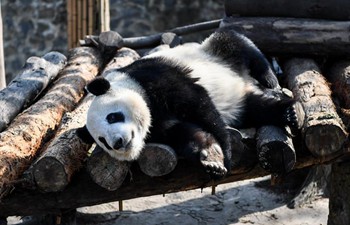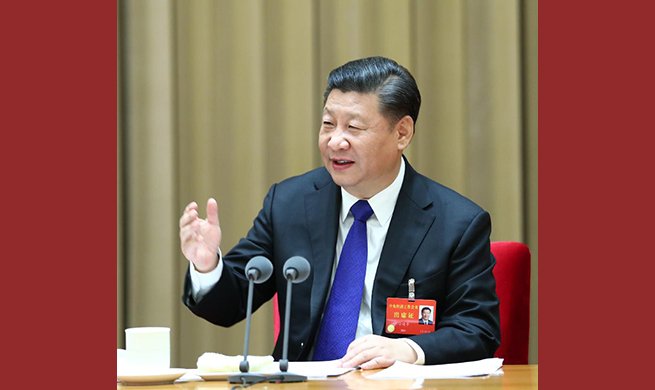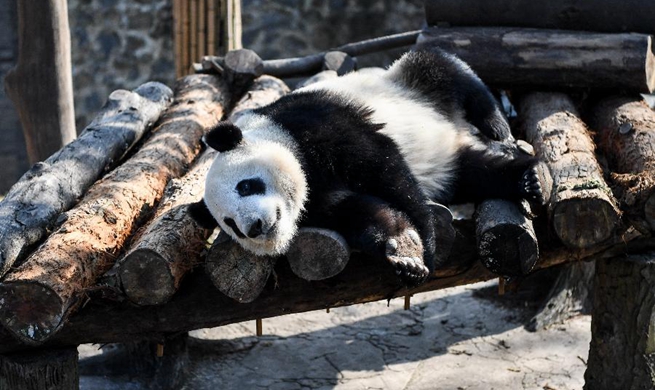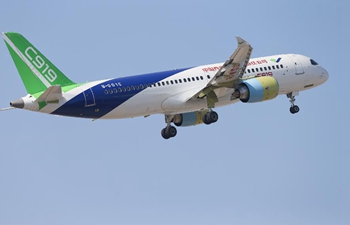by Xinhua writers Xu Jing, Miao Zhuang, Wang Ping
CHICAGO, Dec. 20 (Xinhua) -- The world's largest private seed company Stine Seed joined U.S. President Donald Trump on his visit to China in November, and signed a collaborative agreement with one of its local partners there.
Talking of the agreement, Lijuan Zhao, Stine Seed's Country Manager of China, was excited. "It demonstrated Stine Seed's commitment to the Chinese market and to the Chinese farmers," Zhao told Xinhua, adding that "it will enable us to have a platform to further our expansion in China more efficiently and effectively."
"Our goal is to deliver our high-yielding genetics to as many Chinese farmers as possible. We are very positive on China and very grateful to participate in the world's second largest seed market," Zhao said.
Stine Seed's experience in China is just an epitome of the ever increasing agricultural trade between China and the United States.
EFFORTS AT GOV'T LEVELS
In their first meeting at Mar-a-Lago in Palm Beach, the U.S. state of Florida, in April, U.S. President Trump and Chinese President Xi Jinping initiated a 100-day action plan, with China's re-opening of its market to U.S. beef as top priority.
On June 20, China's General Administration of Quality Supervision, Inspection and Quarantine announced that beef imports from the U.S. were permitted in China.
On June 27, U.S. retail giant Wal-Mart's membership store Sam's Club in Beijing started selling American beef, signaling that China has lifted a 14-year-ban on beef imports from the United States.
The U.S. government, in turn, has pledged to issue regulations on the export of China-made chicken and poultry.
President Trump's visit to China in November also proved fruitful for U.S. farmers: Chinese buyers will buy extra 12 million tons or 5 billion U.S. dollars' worth of soybean from the U.S. in the 2017-2018 seasonal year, among 253.5 billion dollars' worth of economic and trade cooperation intentions reached.
In the intermission, more than 20 Chinese and U.S. enterprises signed agricultural transaction contracts worth 5.012 billion dollars in Des Moines, capital of the Midwest U.S. state of Iowa, in July, under which Chinese enterprises will import 12.53 million tons of soybean and 371 tons of pork and beef from U.S. companies.
This is more than doubling the 2.1-billion-dollar contract value signed by a Chinese delegation in the United States in 2016.
In an effort to ease trade imbalance with the United States, starting from the 1990s, China has sent procurements delegations to the United States. Of China's purchases of American goods, agricultural products are a staple part.
"It seems that our governments are working together to re-establish that opportunity," said Iowa Cattlemen's Association CEO Matt Deppe. "We are excited about that, we are really getting ready to work with the Chinese when that opportunity comes from where our governments are working together, to produce and export the type of products those consumers would be demanding."
China "is a very important market, it is a very important topic both for our governments and producers in our state." "We are really interested and hopeful that the two governments continue to work forward in that direction in a way that's very good for all," Deppe added.
ENTHUSIASM AMONG FARMERS
China is the largest market for American soybeans after the U.S. market itself, importing nearly 30 percent of the soybeans produced in the United States.
Paul Burke, North Asia Regional Director of U.S. Soybean Export Council (USSEC), told Xinhua that U.S. soybean industry has been exploring the Chinese market for 35 years.
"U.S. soybean farmers opened their office in China in 1982. They invested in programs that supported China's goals of achieving sustainable food security and food safety for 13 years before selling their first shipments of soybeans to China in 1995," Burke said.
USSEC, representing 10 U.S. soybean exporters, "will continue to conduct these market development programs in China in efforts to achieve a win-win environment between U.S. soybean producers and the Chinese soybean processing and animal production industries," said Burke, adding the expectations that bilateral relationship "will remain steadfast."
USSEC Country Director of China Xiaoping Zhang estimates that the U.S. will sell a total of 14 billion dollars' worth of soybeans to China by the end of August 2018.
Zhao of Stine Seed echoed Burke's words. Being the world's second largest seed market, "China is of strategic importance to Stine Seed Company," Zhao told Xinhua.
"Our main products are corn and soybean seeds, which are the major field crops in China. And given the similar latitude for the production areas, it's natural for us to try to select our best genetics that also work well for China."
Talking about the agreement signed in November, Zhao said, "The significance of this contract is to allow the U.S. largest privately-held seed company to have a major presence in China."
Iowa Soybean Association CEO Kirk Leeds has visited most of Chinese provinces. "When we go to China, and we do it quite often, it is about relationships. And it is our product meeting your needs. It is less technical, it is less let's-help-you, it is more how-can-we-work-together."
"The soybean industry in Iowa and U.S. recognize that China is a major customer and we have to work very hard to maintain that."
"Any disruptions in the trade and relationship between China and U.S. have serious consequences for American agriculture, and soybean industry specifically. That's why we invest in these relationships. Meeting the consumers there is investing in those relationships," Burke said.
RE-ENTRY OF U.S. BEEF, PORK INTO CHINA
Also notable in the agricultural transaction contracts signed in Des Moines in July is: besides 12.53 million tons of soybean import, Chinese enterprises will buy 371 tons of pork and beef from U.S. companies.
After 14 years' suspension, China has reopened its door to U.S. poultry and meat products in mid-2017.
Iowa Premium Beef is excited about the opportunity, and has applied to export beef to China.
Mikel Gager, Iowa Premium food safety manager, is confident of the quality and safety of his products. "Our facility operates everyday under a very high level of food safety awareness. We have a very fine food safety record."
Covering an area of 200,000 square feet, the plant processes 1,150 head of cattle per day.
Iowa Premium has been in the process of reaching out and trying to build the business contacts with companies that are already doing business with China. "We're trying to build the relationships with those types of companies so that we can get our high quality beef right into the marketplace in China," Gager told Xinhua.
According to statistics of U.S. Department of Agriculture, China has emerged as a major beef buyer in recent years, with imports increasing from 275 million dollars in 2012 to 2.5 billion dollars in 2016.
America is the world's largest beef producer and the world's fourth largest exporter, with global sales of more than 5.4 billion dollars in 2016. Until the ban took effect, America was China's largest supplier of imported beef, providing 70 percent of China's total intake.
It is estimated that China's re-opening of its market to U.S. beef and meat products will benefit some 60 million U.S. cattle ranchers.
AGRICULTURE UNDERPINS CHINA-U.S. TIES
Agricultural products have always been an advantageous product where U.S. holds trade surplus with China.
According to China Customs statistics, bilateral agricultural products trade volume reached 31.2 billion dollars in 2016. China's import from the U.S. was 23.8 billion dollars, while export was 7.4 billion dollars; and China held a trade deficit of 16.4 billion dollars.
U.S. statistics show that China is the second largest destination market of U.S. agricultural products, receiving 15 percent of U.S. agricultural products export.
China is also the first largest destination market of U.S. soybean, receiving 62 percent of its total soybean export; and the second largest destination market of U.S. cotton, receiving 14 percent of its total cotton export.
A U.S. farmer exports about 12,000 dollars' worth of agricultural products to China on average every year.
Stapleton Roy, a former U.S. ambassador to China, told Xinhua: "The agricultural cooperation (between China and the U.S.) became a very important part of the relationship. Most people, most Americans and most Chinese are simply not familiar with this. And yet it is one of the underpinnings of the relationship."
"We are both having agriculture as very important part of our economies. The number of farmers has been going way down in both countries, but the agricultural productivity has been rising very rapidly."
"This is one of the reasons when even we have differences on a whole variety of areas, we have this underpinning of cooperation. And it is very very important to build on that underpinning," Roy added.

















